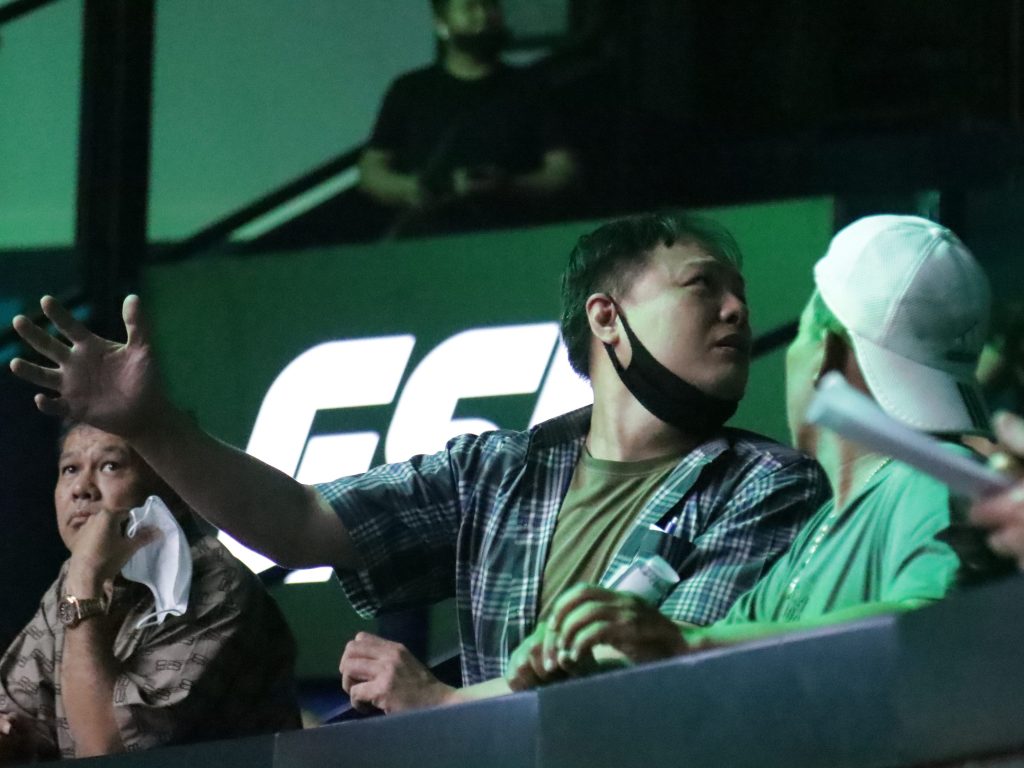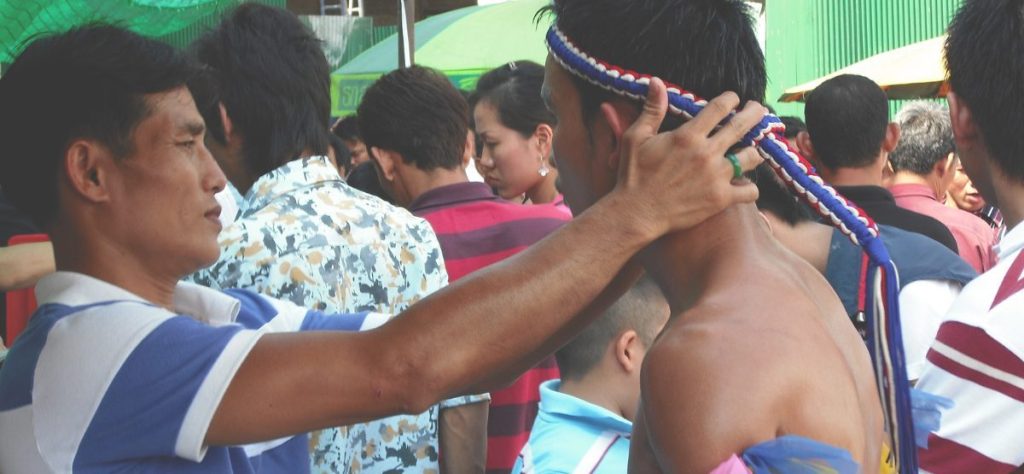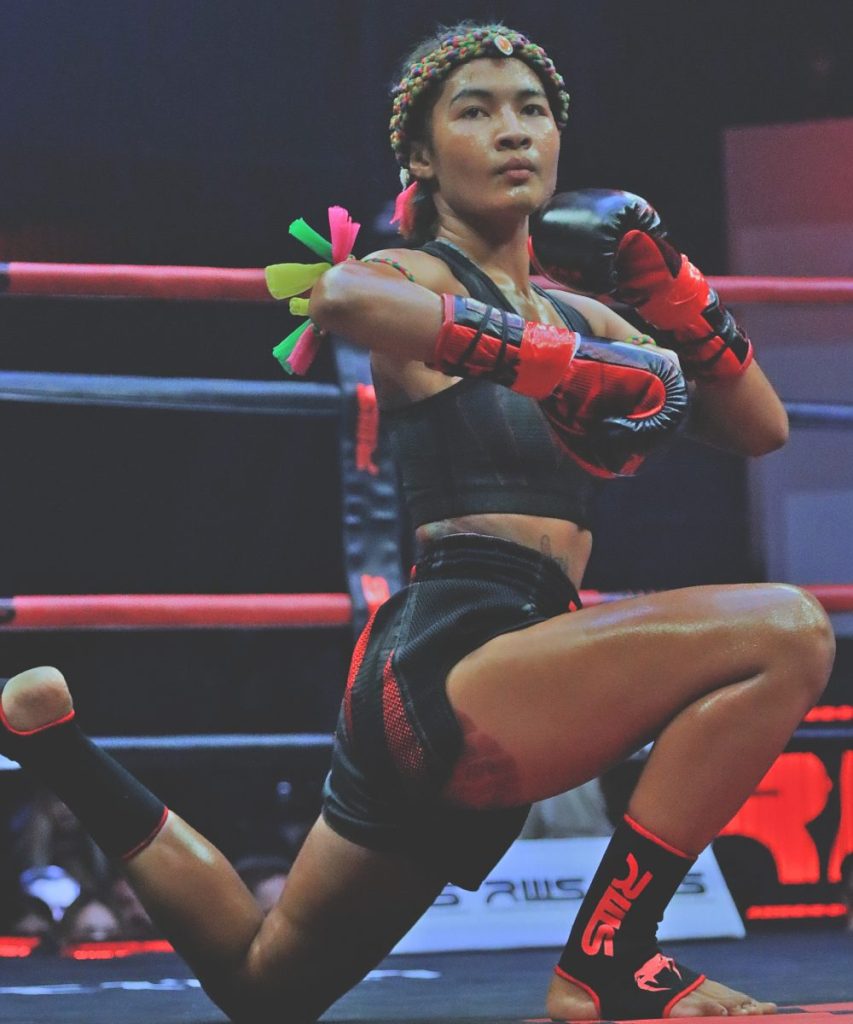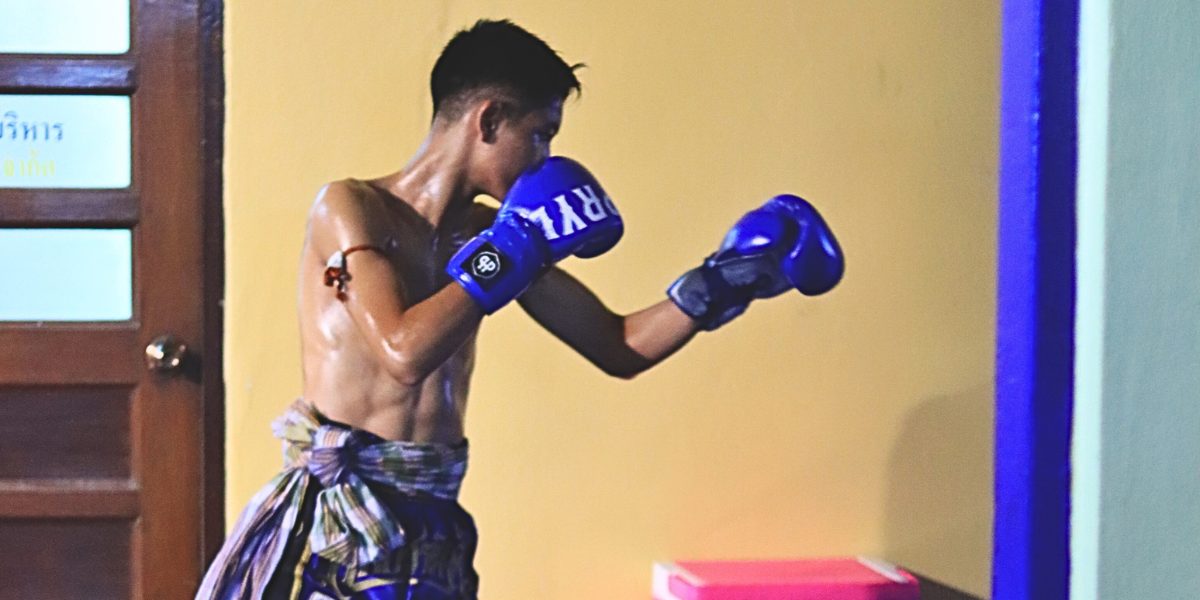Tucked away in the cracks and crevices of Bangkok, there is subculture in which everyone does the same thing, the same thing many people from the subculture have been doing for decades to stay out of poverty — but it’s not painting umbrellas. It’s traditional Muay Thai.
Traditional Muay Thai Fights
Traditional Muay Thai fights consists of five, three-minute rounds but can be as confusing as they are exciting.
For one, the fighters don’t always fight in rounds one and two. Then, in round three – and without notice – the fight explodes into a controlled frenzy, where it continues that way into round four. In round five, the fight dies back down. This leaves the untrained spectator baffled. After all, they’ve just paid to watch an entire fight but get barely half their money’s worth.
There are a few reasons why these things happen.
The fighters tend to fight for the gamblers and, by extending the duration of the fight, they can increase their odds and earn more money. The most important rounds then become three and four. But by the end of round four, the fighters and their cornermen have already determined a winner. However, they do tend to get it wrong from time to time.
Nevertheless, in round five the “winner” backs down to protect his points. If the other fighter concedes defeat, they both dance around the ring, sometimes acting – albeit very badly – as if they are indeed fighting. Other times, the “losing” fighter tries to score a knockout in a final desperate attempt to win.
Gambling And Gamblers In Traditional Muay Thai
TV ratings, spectators, and sponsorships may be the main focus in entertainment Muay Thai but, in traditional Muay Thai, gambling and gamblers are front and center. This both helps and hinders the sport.

If Muay Thai history has told us anything, it’s that not all gamblers are not all bad. In fact, they oftentimes keep the fighters and officials honest. When money is on the line, things could go astray. Fighters take dives, dishonest gamblers bribe fighters, even officials can become corrupt. That said, gamblers know more about the sport and fighters than almost anyone. They can tell when something’s amiss – and they have no problem making it known.
But everything that the gamblers prevent from happening, they also can and have contributed to. Gamblers bribe fighters, rig fights, poison fighters, and have gone as far as attempting or carrying out hits on people in the Muay Thai community. These instances, though, are few and far between. This should never deter you from going to a traditional Muay Thai event. Since 2007, I’ve only seen one fight between the gamblers, and it ended with no bloodshed.
Paid According To How Good A Fighter Is
In entertainment Muay Thai, a fighter gets paid by how much star power he or she has. In traditional Muay Thai, fighters get paid according to where they rank in the stadiums, who they’ve faced, who they’ve beaten, and their standing among the gamblers. Top-ranked fighters can earn as much as 200,000 Thai Baht ($5,500) per traditional Muay Thai fight. They also make money on tips from gamblers and, in some cases, promoters.
Mongkol, Pra Jiads, And Other Sacred Amulets In Traditional Muay Thai
Muay Thai fighters adorn themselves in traditional garb, including the headpiece, known as the mongkol, and the arm bands, known as the pra jiads. They also tend to wear sacred Buddhist amulets either around their necks or attached to their mongkols.
Mongkol
The mongkol is a sacred headpiece that fighters wear to the Muay Thai ring. Although some mongkols are made of braided rope, it’s usually constructed of fabric which is then wrapped around a thick wire, rope, or other flexible item to give it its hold. Fighters sometimes adorn the headpiece with Buddhist amulets.

In order to “activate” the mongkol – that is, give it its supposed special powers – it’s receives a blessing by a monk at a Buddhist temple. The process usually involves the monk holding and praying or chanting over the mongkol.
Usually, a Muay Thai gym has one or two mongkols that all the fighters share. But some fighters have their own mongkol, especially if the fighter is one of the best in the sport.
The mongkol is highly revered. Traditionally, fighters don’t touch the mongkol, although people sometimes overlook this practice overlooked. Also, the mongkol is never allowed to touch the floor or be carelessly handled. When not in use, someone hangs it at a high point of the Muay Thai gym, above the heads of all the fighters and trainers.
The mongkol travels with the team to the stadium – sometimes in a briefcase or sometimes worn around the upper arm and shoulder of a cornerman. Then it’s taped to a high point in the warm-up room. When the fighter’s bout draws near, his cornerman removes the mongkol from the wall, says a prayer over it, and places it on the crown of the fighter’s head.
The fighter then walks to the ring, seals the ring, does the wai kru, and returns to the corner. Once there, his trainer or someone else who the fighter respects, like a father, uncle, or sponsor, removes the mongkol after saying one final prayer. The mongkol is then placed on the turnbuckle of the ring for the remainder of the fight.
Pra Jiads
The pra jiads are the arm bands worn around a fighter’s biceps. They can be made of something as simple as medical gauze or as intricate as a cloth from a family member.
The pra jiads are tied around the fighter’s biceps before the fight – usually right before the mongkol is added to his head.
Unlike they mongkol, a fighter can handle the pra jiads and they don’t usually share them. That is, fighters have their own set of pra jiads. Also unlike the mongkol, the pra jiads remain around the fighter’s biceps for the duration of the fight. They do sometimes slip off, so you may see a referee grab them and launch them out of the ring, mid-fight.
Wai Kru
The wai kru is the dance performed before every traditional Muay Thai fight in Thailand. It happens right after both fighters step into the ring and right before each of them has their mongkol removed. Translated into English, wai kru means “pay respect to the trainer” – but it signifies more than that.

The dance lasts two to three minutes long and not only gives fighters a chance to thank, pray, or pay respect to any number of Thai Animist deities, it also helps them loosen up and settle their nerves before the fight.
Sealing The Ring
Before performing the wai kru, the fighters first seal the ring from bad luck. Although sealing the ring is synonymous with the wai kru, it’s not actually part of the dance.
To seal the ring, the fighters face their respective corner and say a short prayer. Then, calmly and meditatively, they walk the inside perimeter of the ring along the ropes in either clockwise or counterclockwise direction while holding the top rope with one glove. They make their way from corner to corner, being sure to stop and pray in each corner.
Sometimes, the fighters walk in opposite directions and meet somewhere in the middle. When they do, a younger fighter will often move out of the way of an older fighter out of respect. Other times, one fighter will refuse to move out of the way of the other altogether.
The Five Deities
After the fighters seal the ring, they move toward the center and perform the wai kru. Starting on their knees, the fighters go through a set of movements that mimic any number of deities.
Traditionally, the dance goes through fives stages in which the fighter pays respect to deities of a monkey, an elephant, a mystical bird, a swan, and a god-like king. The techniques for each dance’s stages represent the movements of each deity.
Muslim Variation Of The Wai Kru
Because the traditional wai kru involves paying respect to or praying to Thai Animist gods, Muslim fighters perform their own version of the wai kru. They seal the ring just as mentioned above, but instead of performing the five dances mid-ring, they sit cross-legged with open palms and pray.
Criticism Of Traditional Muay Thai
No doubt, traditional Muay Thai has suffered tremendously over the last two decades. Gamblers and gambling, rigged fights, shady promoters and officials, and an overall public disinterest in the sport have caused Thailand’s greatest pastime to fall by the wayside. The reasons listed here, many believe, are what’s holding the sport back from growing.
Where To Watch Traditional Muay Thai Fights In Bangkok
You can watch traditional Muay Thai fights at the following places in Bangkok:
To find out where these venues and all the others in Bangkok are, check out my map of every Muay Thai stadium in Bangkok.



Hi, thanks for the detailed info. We’re interested in watching traditional Muay Thai. Would the Rajadamnern be the best place to go? Is there somewhere outside of Bangkok that would be better/comparable? At the Rajadamnern are the Wai Kru and Ram Muay performed by all fighters on Wednesday and Thursday nights? You don’t mention Sundays for traditional Muay Thai, but the Rajadamnern site labels the Suek Kiatpetch as traditional – is this a mistake? Thanks so much for your help!
Hi Christa,
Rajadamnern holds traditional Muay Thai fights every day of the week except for Saturdays. So as long as you go on these days, you’ll get to see the wai kru/ram muay with every fight.
Outside of Bangkok’s city center you have Siam Boxing Stadium in the Om Noi district. I wrote a guide about hit here: https://muaythaistadiums.com/siam-omnoi-boxing-stadium/
But if you’re looking to watch the best traditional Muay Thai, there is no better place than in Bangkok. And inside Bangkok, there are no better places than Rajadamnern, Siam Boxing Stadium (Saturdays), or Channel 7 (Sundays).
If you only have a Sunday to watch Muay Thai in Bangkok, I’d recommend Channel 7 (https://muaythaistadiums.com/channel-7-boxing-stadium/). It’s free to get in and it is as authentic as you’re going to get. The quality of fights will be much better than a Sunday at Rajadamnern, usually.